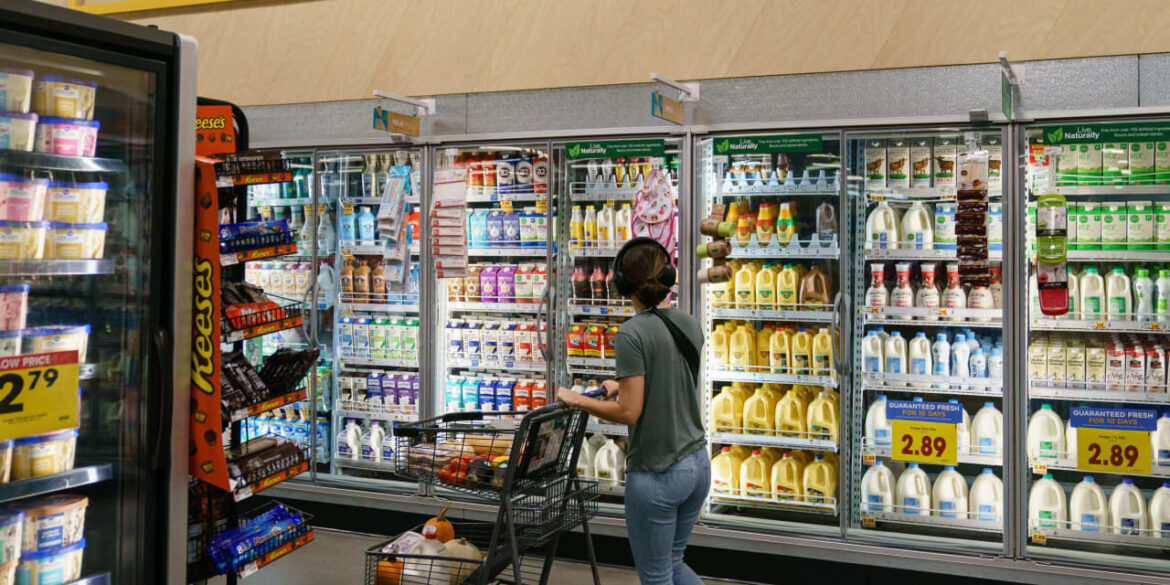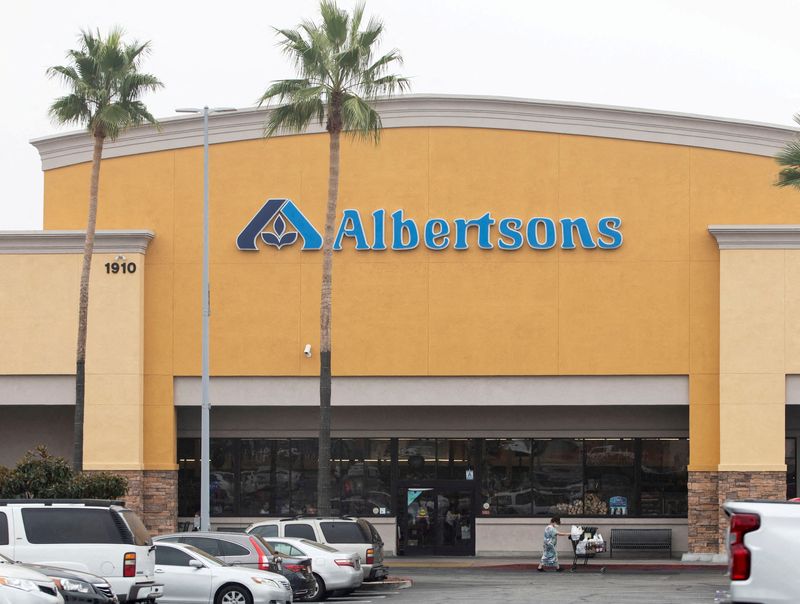
Supermarket chain Kroger Co. on Monday agreed to sell its specialty pharmacy business, saying it would be better off as a standalone segment.
Source link
Kroger
As retailers compete for grocery shoppers, some of the big names in the business have zeroed in on the same strategy: get deliveries to customers’ doors quickly.
This week, Target announced a new paid membership program with free same-day home deliveries as a key perk. Walmart expanded its same-day delivery offering to allow shoppers to get online purchases dropped off earlier in the morning.
And Kroger said Thursday that home deliveries helped propel its more than 10% year-over-year growth in digital sales and 24% year-over-year jump in delivery sales in the most recent quarter.
With same-day deliveries, the three retailers are not only trying to outmatch one another on convenience. They’re also turning brick-and-mortar locations — and the short distance to customers’ homes — into their biggest advantage over Amazon and other e-commerce players, said Michael Baker, a retail analyst for D.A. Davidson.
“This, over the last few years, has completely flipped the switch and turned stores into an asset,” he said.
Walmart is the largest grocer in the U.S., with 23.6% of market share in 2023, according to Numerator, a market research firm. Kroger is second, with 10.1% of market share. Target is the ninth largest grocer by market share, with 2.7%, the firm estimated.
With Target’s announcement this week, Walmart, Target and Kroger will all have paid membership programs with home deliveries as one of the benefits. The subscription services have similar price points and minimums, such as requiring customers to spend at least $35, to get goods dropped at their homes.
Target Circle 360, which launches in early April, will cost $99 per year, but will be $49 for customers who have the retailer’s credit card and for those who sign up during a promotion timed for the program’s launch.
Walmart+ costs $98 per year or $12.95 on a monthly basis, with perks like gas discounts along with free shipping and free grocery deliveries. And Kroger has a program called Boost, which has a $59 per year and $99 per year option. The higher-priced plan includes free delivery within two hours on all orders of $35 or more.
Walmart and Kroger have not shared how many subscribers they have. Target said it has more than 100 million members of Target Circle, its free loyalty program, but it’s unclear how many will sign up for Target Circle 360.
Each of the retailers have tried to stand out from the pack. Target, for example, said it can deliver some online orders in as little as an hour. Walmart said Thursday that it will start making on-demand deliveries as early as 6 a.m. local time. It previously started them at 8 a.m.
Membership programs help offset delivery and shipping costs by charging fees, but they also allow retailers to collect more customer data that can be used to personalize offers or support their growing advertising businesses, D.A. Davidson’s Baker said. They can help drive more frequent online orders, too.
For Walmart, the services are a way to compete in other ways than just price. Walmart CFO John David Rainey has spoken on earnings calls about how Walmart customers are increasingly choosing the big-box retailer for convenience, like its curbside pickup or home delivery options. Those services may also matter more as Walmart tries to retain higher-income shoppers it’s attracted over the past two years while food prices were high.
At Target, same-day deliveries could help to boost sales. The cheap chic retailer’s comparable sales have declined three quarters in a row, and the company expects them to fall again this quarter. It has posted year-over-year digital sales declines for each of the past four quarters.
As customers buy less discretionary merchandise, Target has tried to sell more food and household essentials. Those same items, such as paper towels and cartons of eggs, tend to be the ones that people replenish frequently or need to order in a pinch for a home delivery.
Kroger has used online delivery to break into new regions of the country, including Florida, without opening a single grocery store. It’s built huge fulfillment centers that are powered by automation and robotics from U.K.-based company, Ocado.
On a call with investors on Thursday, Kroger CEO Rodney McMullen described digital as “an important growth accelerator,” and said the company expects another year of double-digit sales growth. He said digital delivered more than $12 billion in sales for 2023. That’s still a small piece of Kroger’s annual revenue, which totaled about $150 billion for the year.
He said digitally engaged customers spend more with Kroger and support growth of its ads business.
McMullen said fierce competition with other grocers, such as Costco and Amazon, has made the grocer race to keep up with customers’ shopping preferences and try to acquire Albertsons. The FTC sued to block that deal last month. He said on the earnings call that Kroger will defend the merger in litigation and expects hearings to start in mid-to-late summer.
He said the company is getting closer to turning its online business into a money maker.
“We’ve always told everybody job one is to make sure we don’t lose the digital customer, and job two is our responsibility to figure out how to make sure that customer is profitable,” he said.
While delivery will help the three retailers overcome unique issues, they still share a common challenge of winning over shoppers who aren’t spending as freely. Walmart and Target both beat Wall Street’s sales expectations for the holiday quarter, but said shoppers are still very value-focused.
Even as Kroger’s shares rose on Thursday, McMullen echoed that on the company’s earnings call.
“They [customers] tell us they’re feeling better more so than their behavior is changing so far,” he said.
Kroger pledges to lower prices for consumers when its planned merger with Albertsons closes
Kroger Inc., facing regulatory pushback over its plan to merge with rival grocery chain Albertsons Cos. Inc. in a roughly $25 billion deal, said Tuesday it typically lowers prices for consumers after consummating a deal.
Critics of the deal have argued it’s more likely to lead to higher prices as it will further reduce competition, especially after both companies have been aggressive and active acquirers of smaller retailers with at least $19.5 billion of deals since 1998, as the New York Times reported in 2022. The biggest deal was Albertsons’ $9.4 billion takeover of Safeway in 2014.
“We believe the way to be America’s best grocer is to provide great value by consistently lowering prices and offering more choices,” Kroger
KR,
CEO Rodney McMullen said in a statement on Tuesday.
“When we do this, more customers shop with us and buy more groceries, which allows us to reinvest in even lower prices, a better shopping experience, and higher wages.”
The retailer invested more than $125 million to lower prices at Harris Teeter after a 2014 merger, he said. It spent more than $100 million to cut prices at Roundy’s after a 2016 deal, he added.
That move and other measures reduced its gross margin by 5% over the last 20 years, it said, while rivals such as Amazon.com Inc.
AMZN,
Ahold Delhaize
AD,
Walmart Inc.
WMT,
and Dollar General Corp.
DG,
have grown margins by 22%, 4%, 1% and 2%, respectively in the same period, according to Kroger’s estimates.
Critics of the Kroger/Albertsons
ACI,
tie-up have argued that the combined entity was more likely to raise prices, especially after food companies enjoyed record profits during the pandemic thanks to their pricing power.

Albertsons
Kroger and Albertsons also need to persuade regulators that the merger will increase competition even as it further consolidates the market. Opponents of the deal include a bipartisan group of attorneys general, who have sued Albertsons to block the payment of a nearly $4 billion special dividend until regulators complete a review of the proposed merger.
The deal also comes during a period of high inflation that has made shoppers weary and eager to find bargains. In its most recent earnings report from November, Kroger offered cautious guidance citing continued near-term economic pressures and food-at-home disinflation.
The Cincinnati-based company has been selling stores and making concessions to get the Albertsons deal over the line. It said its customers were showing signs of pressure from higher interest rates, reduced savings and fewer government benefits, even as inflation is decelerating.

Kroger
In January, Kroger and Albertsons said they remain in active dialogue with the Federal Trade Commission and individual state Attorneys General.
But they said the close was more likely to happen during the first half of Kroger’s fiscal 2024, which stretches through Aug. 17.
“While this is longer than we originally thought, we knew it was a possibility and our merger agreement and divestiture plan accounted for such potential timing,” the companies said in a joint statement.
Kroger has pledged to spend $500 million post-close to lower prices and to invest $1.3 billion to enhance the customer experience and $1 billion to support wages. The company has further said it would not close stores, distribution centers or manufacturing facilities, or lay off front-line employees. The combined entity will have more than 700,000 part-time and full-time employees.
Kroger’s stock was down 0.6%, and has gained 1.7% in the last 12 months, underperforming the S&P 500
SPX,
which has gained 21%.
Kroger, Albertsons plan to offload over 400 stores for close to $2 billion-sources
By Anirban Sen and Abigail Summerville
(Reuters) – Kroger Co and Albertsons Cos Inc are nearing a deal they hope will secure U.S. regulatory clearance for their proposed $24.5 billion merger, by selling more than 400 grocery stores to C&S Wholesale Grocers for nearly $2 billion, according to people familiar with the matter.
The deal would give privately held C&S, primarily a supplier rather than an operator of grocery stores, a much more significant footprint. It currently operates about two dozen stores under the Grand Union and Piggly Wiggly brands.
SoftBank Group Corp, the Japanese investment group, is in talks with C&S about helping finance a small portion of the deal, one of the sources said.
While SoftBank typically opts for technology-related deals, it has ties to C&S executive chairman Rick Cohen, because it has a joint venture with warehouse automation company Symbotic Inc, where Cohen serves as CEO.
The stores that Kroger and Albertsons plan to shed are primarily in the Pacific Northwest and the Mountain states, along with some in California, Texas, Illinois, and the East Coast, the sources said.
An agreement may be reached as early as this week, they said, adding it remained unclear whether it will allay regulators’ fears that a combined Kroger and Albertsons would have too much control over grocery prices.
The sources requested anonymity because the negotiations are confidential. Kroger and Albertsons declined to comment. C&S and SoftBank did not respond to requests for comment. Bloomberg News reported about the talks between C&S, Kroger and Albertsons on Monday, as well as SoftBank’s involvement but gave no information about the deal terms.
Previously, Kroger and Albertsons said they may divest between 100 and 375 stores by placing them in a new company that Albertsons shareholders would own. In a regulatory filing Kroger said the upper limit for divestitures was 650 stores.
C&S has been looking to build its own store presence in a fiercely competitive market for supplying groceries. It lost one of its largest customers when Ahold Delhaize decided to transition to self-distribution in 2019.
(Reporting by Anirban Sen and Abigail Summerville in New York; additional reporting by Juby Babu in Bengaluru, Editing by Sherry Jacob-Phillips, Rashmi Aich and David Gregorio)




